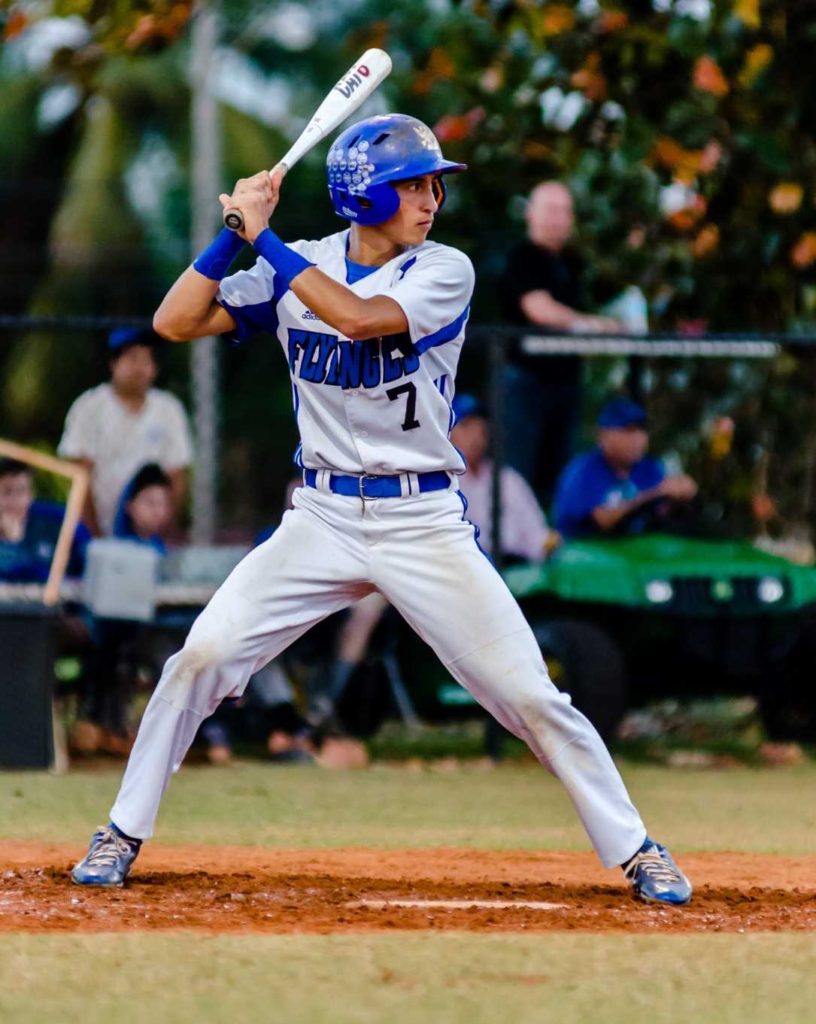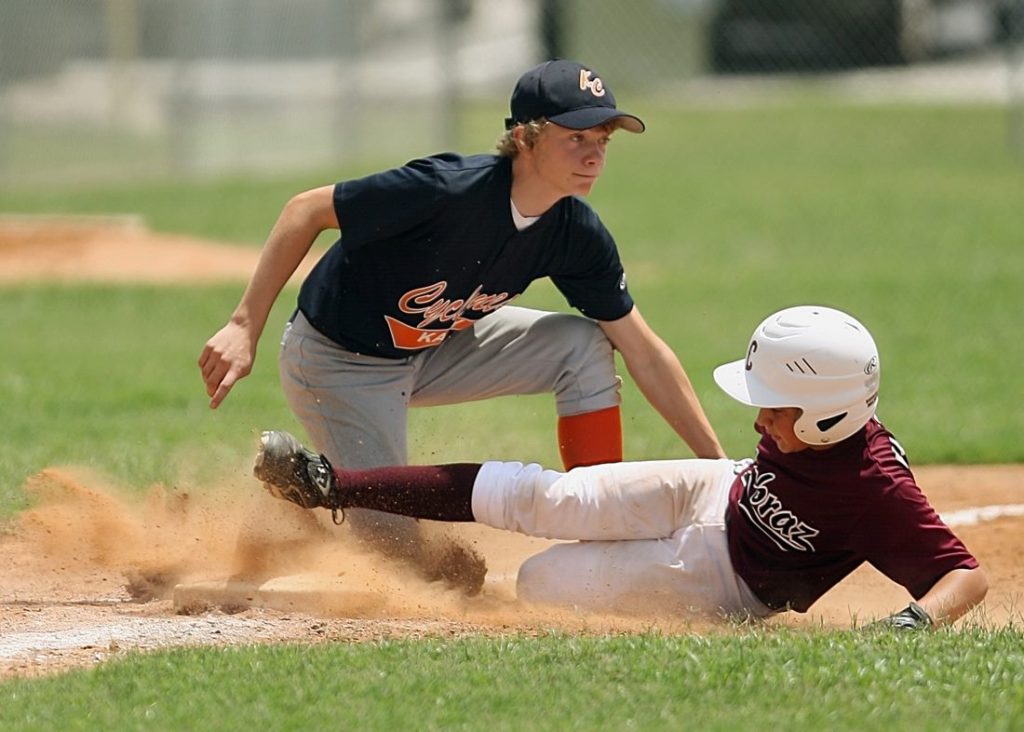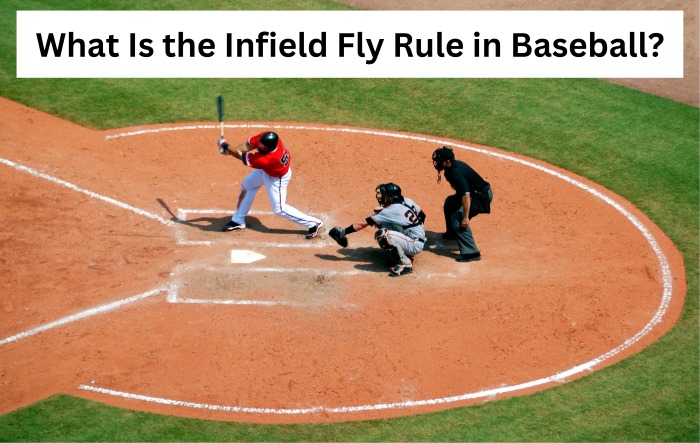Back in my playing days, standing up to bat was always a thrill. There I was, facing the pitcher, feeling the buzz from the crowd, and hoping to hit the ball just right.
But let’s keep it simple: not every hit was a winner. Sometimes, I’d hear “Infield Fly, batter’s out!” before anyone even caught the ball, and I’d be heading back, thinking about what just happened.
Now, as a school coach, I feel like it’s my job to break down these complex parts of baseball so the next generation doesn’t have the same bewildered look I had.
So, if you’re scratching your head thinking, “What is the Infield Fly Rule in Baseball?” and “Why is it important?” stay with me. I’m going to share what I’ve learned from years of playing and coaching to help you get it. Let’s get going!
What Does “Infield Fly” Mean In Major League Baseball (MLB)?
An “Infield Fly” is when a batter hits a ball that flies up in the air, that is not too high or too low, and it looks like an easy catch for the player in the infield area. It applies mainly when players are standing on first and second base or when all the bases have players on them, and there are one or no outs.

Is it a big deal? Absolutely, especially for the team that’s batting. Why? Because when the umpire calls an Infield Fly, the batter is automatically out, no matter if the ball is caught or not.
This rule prevents the fielding team from turning an easy catch into a sneaky double or triple play by intentionally not catching the ball.
In the video below, you’ll find a detailed account of how the infield fly rule works.
Infield Fly Rule in MiLB
Minor League Baseball (MiLB) is where future MLB stars get their start. So, you must familiarize yourself with the same rules you’ll face in the MLB.
How Does It Work?
MiLB follows the rules quite similar to the MLB, including the Infield Fly Rule. It applies when there are runners on first and second base or when all bases are occupied with fewer than two outs, and the batter hits a fly ball that an infielder can catch with “ordinary effort“.
Infield Fly Rule in Softball
Now, let’s talk about the Infield Fly Rule in softball. It also shares similarities with baseball, but many differences are there.
How Does It Work in Softball?
In softball, the Infield Fly Rule applies when runners are on first and second base or when all bases are occupied with less than two outs. If the batter hits a fly ball that an infielder can catch with “ordinary effort,” the rule becomes applicable.
Generally speaking, the Infield Fly Rule is less important in softball than in baseball. This disparity is due to softball’s shorter base paths, which measure 60 feet instead of baseball’s 90-foot base tracks.
Because of the shorter distances in both fast-pitch and slow-pitch softball, the defensive team has far less time to take advantage of a purposeful or unintentional lost infield pop-up.
However, in major league baseball, where the basepaths extend to 90 feet, the Infield Fly Rule holds tremendous significance.
Origins of the Rule
The infield fly rule originated back in the early 20th century. Back in those days, players were always on the lookout for a sneaky advantage to turn the tide in their favor.
And here’s where the scenario leading to the infield fly rule comes into play: Bases are loaded, the tension is high, and the batter hits a pop fly into the infield.
Now, under normal circumstances, this would be an easy out. But savvy infielders saw it as an opportunity. Instead of catching the ball, they’d let it drop intentionally, quickly picking it up and turning the play into a cunning double or triple out.
It didn’t take long for the baseball community to recognize this clever yet unsporting tactic. There was a collective call for action, a shared sentiment that something needed to be done to preserve the fair play spirit of the game.
That’s when the custodians of baseball stepped in. The response?
In 1895, the infield fly rule was officially introduced to Major League Baseball. The aim was clear – no more exploiting loopholes, no more cunning plays.
The rule was a game-changer, quite literally! Suddenly, the sneaky advantage was gone; the field was leveled, and the essence of fair competition was restored.
Criteria for the Infield Fly Rule
For an infield fly to be called, certain criteria need to be met:
- There must be less than two outs in the inning.
- There have to be runners on first and second base, at a minimum.
- The batter hits a fly ball that can be caught by an infielder with reasonable effort.
Purpose of the Infield Fly Rule in Baseball
The purpose of this rule is to protect the fielding team. Without it, a simple pop-up could easily turn into a double or triple play, penalizing the offense for what is typically routine play.
It’s a balancing act in the rulebook, ensuring fair play. The batter is automatically out when the rule is invoked, protecting the runners and maintaining the spirit of the game.
Controversies
The infield fly rule has caused a lot of heated debates and raised eyebrows over the years. Why?
Because it often hinges on what “ordinary effort” means when we talk about an infielder catching the ball.

What might seem like a routine catch to one person might look challenging to another. And it’s this gray area that has led to so many disagreements.
People often ask: Was the infielder close enough? Was the catch easy enough? These questions have set off countless heated discussions among fans.
A perfect example of this controversy unfolded in 2012. Yes, I’m talking about the playoff between the Braves and the Cardinals.
The Braves’ Andrelton Simmons hit a fly ball in the 8th inning when there were runners on first and second base and one out. But it didn’t go very deep and landed in the shallow part of the left field.
The umpire quickly said it was an “infield fly“, declaring the batter out. But in a twist of events, the ball landed safely on the ground, untouched by any player.
The Braves fans brutally disagreed with the decision. They felt that the ball wasn’t a guaranteed easy catch, so the rule shouldn’t have been used. In their frustration, some even started throwing debris onto the field. So, the game paused.
Watch this video to find out what actually happened:
NL WC: Umps call infield fly rule on Simmons’ popup
This event had people talking and debating for quite a while. Baseball experts, players, and everyday fans dissected the situation from every angle.
What this incident highlighted was how crucial these split-second decisions are in baseball. They affect the outcome of a match and, in this case, a team’s postseason fate.
Frequently Asked Questions (FAQS) About Infield Fly Rule in Baseball
1. What happens if the umpire does not call Infield Fly?
If the umpire does not call Infield Fly, it can lead to controversy. The batting team will be at a disadvantage as it opens up the opportunity for easy double or triple plays.
2. Can an Infield Fly be in the outfield?
Interestingly, yes! The rule states that the ball must be catchable by an infielder with ordinary effort. So, if an infielder goes into the outfield to make the catch, it can still be ruled an infield fly.
3. Can runners run on an Infield Fly?
Runners can indeed advance at their own risk on an infield fly. If the ball is dropped, they can try to take an extra base, but they must be wary of getting thrown out.
4. Can a pitcher catch an Infield Fly?
Absolutely, the pitcher is considered an infielder in this scenario. If the pitcher can catch the ball with ordinary effort, the infield fly rule can be invoked.
5. Can an Infield Fly be foul?
No, an infield fly must be a fair ball. If it’s foul, the infield fly rule does not apply, and it’s just a regular foul ball.
6. What happens if you drop an Infield Fly?
If a fielder drops an infield fly, the batter is still out. However, the ball is live, and runners can advance at their own risk.
7. Which umpire calls an Infield Fly?
Typically, the home plate umpire or an umpire stationed near the bases will call an infield fly.
8. Can you call an Infield Fly after the play?
No! According to the rules of baseball, the umpire must make the Infield Fly call at the very moment the ball is in the air.
9. How high does an Infield Fly have to be?
The rule doesn’t specify a height, but it must be hit high enough to give a fielder enough time to get under the ball and make an ordinary effort catch.
10. How many outs are in the Infield Fly rule?
The batter is declared out, so one out is recorded when the infield fly rule is invoked.
My Opinion On Infield Fly Rule In Baseball
So, what’s the takeaway from an Infield Fly? It is a situation where the batter hits a fly ball that should be easy to catch, and it results in an automatic out.
From my playing days to now coaching young talent, my view on the Infield Fly rule has really changed. I remember the sting of hearing “Infield Fly” and knowing I was out before the ball even landed.
But as a coach, I see the rule in a new light. Every Infield Fly is a chance to think about strategy, a moment for players to ponder how they play the game, no matter if they’re the batter, a runner, or a fielder.
It’s all about understanding the game better and growing from each experience. Sure, it might seem a bit tough at first. But once you understand, you’ll see how it adds depth to the game. So, my advice? Embrace it and learn from it!
More Resources
What Is A Pinch Hitter In Baseball

Hello everyone. My name is Jason Butler, and I live in California, America. I was a professional AAA Minor League Baseball player. I lost my chance of playing MLB for injury issues, but I did not lose my love for baseball. I attended the coaching training program and am now working as a coach in a small school in San Diego.
I always love to share my experience and knowledge if that can help you. Play baseball, and stay fit.
